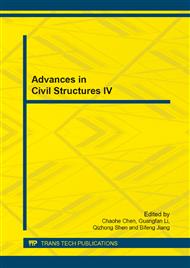p.1224
p.1228
p.1233
p.1240
p.1247
p.1251
p.1257
p.1262
p.1266
Vibration Test of Hangzhou East Railway Station under Pedestrian Load
Abstract:
Much concern has been paid on the human-induced vibration of high-speed railway station structures in recent years. But the vibration responses are influenced greatly by are two key factors, which are rational pedestrian load model and accurate structure calculation model. Field test, therefore, is the most directly and valuable method to obtain the vibration responses of large-span railway station structure. The vibration responses of the waiting floor of the Hangzhou East Railway Station, which is just completed, are measured and analyzed. The test results showed that the vibration of waiting room floor under pedestrian load cannot be neglected for vibration comfort evaluation.
Info:
Periodical:
Pages:
1247-1250
Citation:
Online since:
July 2014
Authors:
Keywords:
Price:
Сopyright:
© 2014 Trans Tech Publications Ltd. All Rights Reserved
Share:
Citation:


